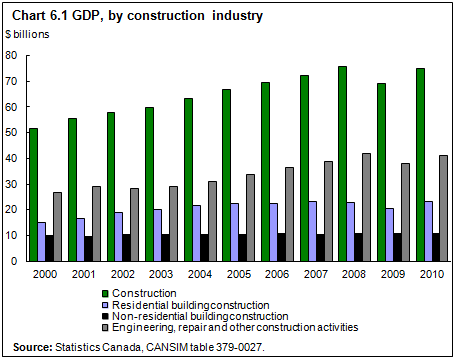Construction
Archived Content
Information identified as archived is provided for reference, research or recordkeeping purposes. It is not subject to the Government of Canada Web Standards and has not been altered or updated since it was archived. Please "contact us" to request a format other than those available.
Related information
Construction is a major industry in Canada, employing more than 1.2 million men and women. In 2010, 7.1% of employed Canadians aged 15 and older worked in the construction industry, an increase of 50.8% since 2000, when 806,900 people worked in construction.
Historically, employment in construction has been more sensitive to the ups and downs of the economy, and this held true in 2009 and 2010. In 2009, during the 2008–2009 recession, overall employment decreased 1.6%, while employment in construction fell 5.7%. In 2010, when the economy saw signs of improvement, employment in all industries grew 1.4%, while employment in construction advanced 4.9%.
Construction is an important contributor to the economy. In 2010, Canada's construction industries—residential, non-residential and engineering, repair and other construction services—accounted for 6.0% of Canada's gross domestic product (GDP), contributing $73.8 billion. From 2000 to 2010, construction GDP increased 42.7%, whereas GDP for all industries increased 20.2%.
Among the three component industries, engineering, repair and other construction services contributes the largest share to construction GDP. In 2010, it accounted for 54.0% of construction GDP, or $39.9 billion. Residential building construction contributed $23.4 billion, while non-residential building construction contributed $10.8 billion.
Value of building permits up
After decreasing 13.3% in 2009, the value of building permits rose in 2010 to reach $72.4 billion—a gain of 18.7%. From 2000 to 2010, the value of building permits rose 96.1%, peaking in 2007 at $74.4 billion.
Industrial building permits gained the most ground in 2010, increasing 32.6% to $5.1 billion. Residential building permits also advanced, increasing 25.2%. Residential building permits reached a value of $43.5 billion and accounted for 60.0% of all building permits.
From 2009 to 2010, the value of building permits increased 10.0% in non-residential and 10.9% in the commercial sector, whereas they declined 1.6% in the institutional and governmental sector.
Mixed year for housing market
In 2010, Canada's housing market underwent a mixed year. New housing prices increased 2.2% from 2009; however, average annual home resale prices were up 5.8%. In 2010, the volume of resales reached 446,577, down 3.9% from 2009, and 14.2% below the peak year of 2007.
In 2010, Newfoundland and Labrador recorded the fastest provincial increases as new housing prices rose 5.9% and resale prices advanced 14.0%.
Elsewhere in the Atlantic region, new housing prices fell 1.6% in Prince Edward Island, while Nova Scotia posted a 0.9% gain and New Brunswick saw a 1.6% increase. Resale prices rose 0.8% in Prince Edward Island, 4.8% in Nova Scotia and 1.5% in New Brunswick.
In 2010, both new housing prices and resale prices increased in Quebec. New housing prices increased 3.0% and resale prices gained 7.1%. In Ontario, new housing prices increased 2.4%, while resale prices rose 7.5%.
In the Prairies, Manitoba posted a 4.8% increase in new housing prices in 2010, while prices increased 3.9% in Saskatchewan and 0.5% in Alberta. Home resale prices rose 10.3% in Manitoba and 4.0% in Saskatchewan, while they increased 3.1% in Alberta, following two consecutive annual declines.
In 2010, new housing prices were up 2.6% in British Columbia, while home resale prices rose 8.5%, reaching a record high average annual price of $505,200.
Less investment in non-residential construction
In 2010, investment in non-residential construction totalled $28.4 billion in 2002 constant dollars, a 0.6% drop from 2009. Investment in industrial buildings dropped 3.6% and commercial buildings fell 2.6%, while institutional and governmental buildings increased 4.3%.
Provincially, Nova Scotia (14.5%), and New Brunswick (12.2%) had the largest gains in non-residential investment, while the largest decreases were in Prince Edward Island (25.2%) and Alberta (8.1%).
From 2000 to 2010, investment in non-residential building construction rose 17.7% from $24.1 billion to $28.4 billion, after peaking at $29.1 billion in 2008. During this period, investment in industrial building construction declined 51.9%, whereas investment in commercial buildings climbed 32.7%. Investment in institutional and governmental construction grew 58.5%, the greatest growth in non-residential construction over the decade.

View data source for chart 6.1
- Date modified:
